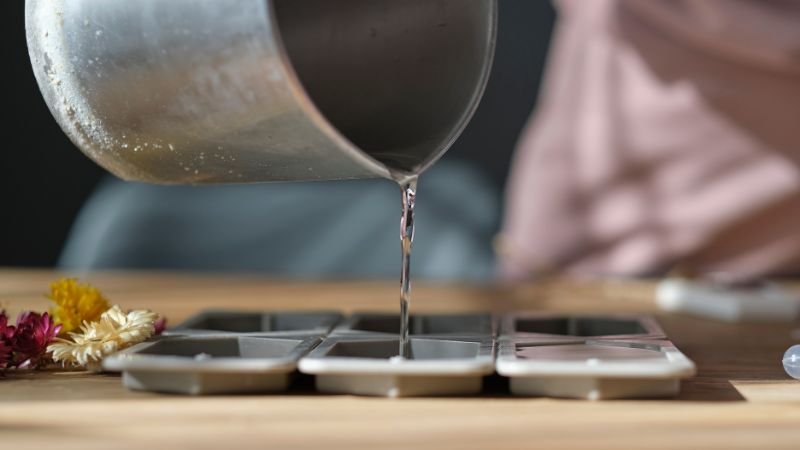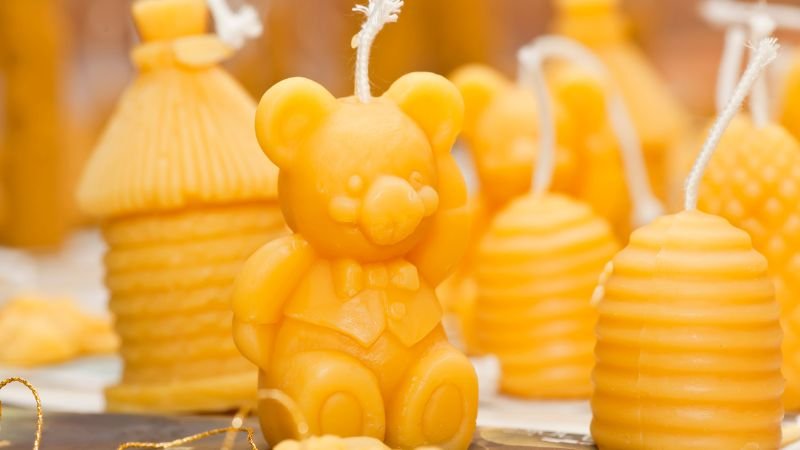Welcome to the world of silicone candle molds! This guide is your doorway into the creative and practical use of silicone molds in candle making. Whether you’re a beginner or a seasoned pro, these molds open up a world of possibilities, allowing you to craft candles in a variety of shapes and sizes with ease. Let’s dive into the art and technique of using silicone molds, and unlock the potential of your candle-making creativity!
Types of Silicone Candle Molds
Exploring the different types of silicone candle molds will reveal a world of possibilities, each suited to specific occasions and settings. Let’s delve into these types and discover how each can enrich your candle-making artistry:
Pillar Molds
- Description: Pillar molds are the quintessence of classic candle making, yielding upright, cylindrical candles.
- Ideal Use-Case: Perfect for creating statement pieces, these candles are ideal for centerpieces at dinner tables, weddings, or as standalone decorative elements in living rooms. Their robust size also allows for longer burning times, making them suitable for extended events or as enduring home decor.
- Setting: Imagine a pillar candle aglow, casting a warm light over a cozy family dinner, or adding a touch of elegance to a quiet reading nook.
Taper Molds
- Description: Taper molds produce slender, tall candles, known for their sophisticated and elegant appearance.
- Ideal Use-Case: These candles are traditionally used in pairs for romantic dinners, placed in elegant candlesticks for classical decor, or in religious ceremonies. They’re perfect for settings that require a touch of grace and refinement.
- Setting: Picture a pair of taper candles illuminating an intimate anniversary dinner, or adding a ceremonial touch to traditional holiday gatherings.
Votive Molds
- Description: Votive molds are smaller and typically used for making votive candles, which are short and squat.
- Ideal Use-Case: Votive candles are excellent for scattering around the house to create a warm, inviting atmosphere. They’re also commonly used in spas, bathrooms, and as part of small decorative clusters.
- Setting: Envision several votive candles flickering softly in a spa, providing a tranquil and serene ambiance, or clustered on a mantlepiece to add a cozy glow to a living room.

Unique Shapes
- Description: These molds come in various imaginative shapes, from flowers to stars, offering a canvas for creativity.
- Ideal Use-Case: Unique shape molds are perfect for themed parties, special occasions, or as personalized gifts. They can match decor themes or serve as conversation starters.
- Setting: Visualize a birthday party with star-shaped candles adding whimsy to the decor, or heart-shaped candles as wedding favors, symbolizing love and unity.
3D Molds
- Description: 3D molds allow for the creation of intricate, multi-dimensional candles, showcasing detailed designs.
- Ideal Use-Case: These are excellent for making statement pieces for display, unique gifts, or for special occasions where a regular candle just won’t do. They can replicate objects, characters, or complex patterns.
- Setting: Think of a 3D candle in the shape of a pinecone during the holidays, adding a festive element to your decorations, or a floral-shaped candle as a centerpiece in a spring-themed party.
Specialized Molds for Candle Holders and Jar Candles
- Description: Beyond traditional candle shapes, these specialized molds allow for creating unique candle holders and jar candles.
- Ideal Use-Case: They’re perfect for DIY enthusiasts looking to create complete candle displays or those interested in making candles that double as home decor items.
- Setting: Imagine a custom-designed candle holder, glowing with light on a coffee table, or a jar candle, with layers of colored wax, sitting elegantly on a bookshelf.
Candle Molds Material and Quality
The material of these molds is crucial. Silicone, known for its flexibility and heat resistance, is the ideal choice for candle molds.
Why Silicone is a good material for Candle making?
Compared to other materials like plastic or metal, silicone stands out for its flexibility and non-stick properties, making candle removal a breeze.
| Feature / Mold Type | Silicone Candle Mold | Plastic Candle Mold | Metal Candle Mold |
|---|---|---|---|
| Material Flexibility | Highly flexible; easy to manipulate | Less flexible than silicone | Rigid and non-flexible |
| Durability | Highly durable; resistant to damage | Prone to cracking with repeated use | Extremely durable; withstands high temperatures |
| Ease of Candle Removal | Very easy; flexible material allows for simple demolding | Can be difficult; less flexibility | Variable; can be challenging due to rigidity |
| Heat Resistance | Excellent; withstands high temperatures | Limited; can deform under high heat | Excellent; ideal for high-temperature use |
| Price | Generally more expensive | Usually less expensive | Price varies; often more expensive than plastic |
| Variety of Shapes | Wide range of intricate designs and shapes | Limited by rigidity; basic shapes | Good variety, but less intricate than silicone |
| Maintenance | Easy to clean; usually dishwasher safe | Requires careful cleaning to avoid damage | More challenging to clean; requires careful handling |
| Lifespan | Long; maintains shape and quality over time | Shorter; may degrade with heat and use | Very long; metal molds last for many years |
| Environmental Impact | More eco-friendly; often made from food-grade silicone | Less eco-friendly; made from various plastics | Variable; depends on the type of metal and production process |
| Ideal Use | Versatile for both professional and hobbyist candle making | Best for hobbyists or low-volume production | Preferred for professional, high-volume candle making |
This table provides a snapshot of how silicone, plastic, and metal candle molds compare across various important features. Each type has its own set of advantages and disadvantages, making them suitable for different candle-making needs and preferences.
High-Quality Silicone Candle Molds
The best silicone for candle molds is durable and resilient, allowing for repeated use without losing its shape or functionality.
When selecting a silicone mold, it’s important to consider these qualities. A good mold can be a trusty companion in your candle-making journey, consistently delivering beautiful results.
Making Candles with Silicone Molds
1. Preparation and Setup
Before we dive into the hands-on process of candle making, it’s crucial to get your setup right. Proper preparation lays the foundation for crafting the perfect candle.
- Choosing the Right Wax: Your choice of wax is essential, as different types of wax have unique properties that affect the candle’s performance and appearance. Here’s a quick comparison to help you decide:
| Wax Type | Melting Point | Scent Throw | Burn Time | Environmental Impact | Melting Temperature Range |
|---|---|---|---|---|---|
| Paraffin | High | Excellent | Shorter | Higher | 120-160°F (49-71°C) |
| Soy Wax | Medium | Good | Longer | Lower | 120-180°F (49-82°C) |
| Beeswax | High | Natural | Longer | Lower | 145-175°F (63-79°C) |
| Palm Wax | Medium | Good | Longer | Variable | 130-160°F (54-71°C) |
| Gel Wax | Low | Variable | Variable | Higher | 185-220°F (85-104°C) |
- Preparing Your Molds: Now, onto your silicone molds. Ensure they are clean and completely dry. Any leftover moisture or residue can affect your candle’s finish and burning quality.
- Wick Placement: Getting the wick placement right is key. The wick should be centered and securely held in place, perhaps with a holder or a dab of adhesive. Proper placement ensures that your candle burns evenly and efficiently.
With your wax selected and your molds and wicks ready, you’re all set to start the exciting process of making your own candles!

2. Candle Making Process
Now, for the heart of candle crafting – the making process. It’s simpler than it sounds, and with silicone molds, it’s quite a smooth ride.
- Melting the Wax: Choose your wax – be it beeswax, soy, or paraffin. Melt it slowly in a double boiler, keeping an eye on the temperature.
- Pouring the Wax: Once melted, let the wax cool slightly before pouring it into the mold. This helps prevent any warping or damage to the mold.
- Setting and Cooling: After pouring, let your candle cool and set. This can take several hours, but patience is key for the best results.
- Removing the Candle: The beauty of silicone molds is the ease of removal. Once set, gently pull away the mold and reveal your candle creation.
Each step in this process offers a chance to add personal touches, whether it’s through the type of wax, the addition of colors, or the incorporation of fragrances. The flexibility of silicone molds opens up a world of creativity in candle making.
Advanced Techniques and Creative Ideas
1. Advanced Molding Techniques
Once you’ve mastered the basics, it’s time to step up your game with some advanced techniques. These methods can bring a whole new level of sophistication to your candle creations.
- Creating Custom Silicone Molds: If you’re feeling adventurous, you can create your own silicone molds. This opens up endless possibilities for personalized candle shapes.
- Multi-colored and Layered Candles: Experiment with adding layers of different colored waxes or embedding objects like dried flowers or glitter into your candles for a unique touch.

2. Creative Projects
Now, let’s unleash your creativity! Silicone molds are fantastic for more than just traditional candles. Here are some ideas to spark your imagination:
- Themed Candles: How about seasonal candles? Think spooky shapes for Halloween or festive designs for Christmas. Themed candles are great for decoration or as thoughtful gifts.
- Scented and Aromatherapy Candles: By adding essential oils to your wax, you can create candles that not only look beautiful but also fill the room with soothing or invigorating scents.
- Decorative Candles: Silicone molds enable you to create candles that are so pretty, they double as art pieces. You can play with textures, embed different materials, or use striking color combinations.
The key is to experiment and have fun. With silicone molds, the only limit is your imagination. So, why not try something new and see where your creativity takes you?
Tips and Troubleshooting
Maintaining your silicone molds and troubleshooting common issues is crucial for any candle maker. Let’s delve into some essential tips and solutions to keep your candle-making journey smooth.
1. Maintenance and Care
Proper care extends the life of your silicone molds and ensures consistent quality in your candle creations.
- Cleaning Your Molds: After each use, clean your molds with mild soap and warm water. Avoid harsh chemicals or abrasive brushes, which can damage the silicone.
- Storing Molds: Store your molds in a cool, dry place away from direct sunlight. Flat storage is best to prevent warping.
2. Troubleshooting Common Issues in Candle Making with Silicone Molds
While silicone molds make candle making more accessible, certain challenges can still arise. Here are some expanded tips to help you overcome these common issues:
Difficulty Removing Candles from Molds
- Problem: Sometimes candles stick to the molds, making them hard to remove without damage.
- Solution: Place the mold in the freezer for about 10-15 minutes. The cold will cause the wax to contract slightly, making it easier to unmold. Also, ensure that the candle is fully set before attempting to remove it.
Air Bubbles in the Candle
- Problem: Air bubbles can form in the wax, leading to an uneven surface and potentially affecting the burn quality.
- Solution: After pouring the wax, gently tap the mold on a hard surface to release trapped air. Pouring at a slightly cooler temperature can also help reduce bubble formation. If bubbles appear on the surface, you can use a heat gun or hair dryer on a low setting to gently warm the surface and remove them.
Wick Drifting or Uncentered
- Problem: Wicks can sometimes drift from the center or not stay upright, leading to uneven burning.
- Solution: Secure the wick with a holder or adhesive to the bottom of the mold before pouring the wax. You can also use wick centering tools or makeshift guides like chopsticks or pencils to keep the wick centered and straight as the wax sets.
Cracking or Frosting on Candles
- Problem: Candles can sometimes develop cracks or a frosty appearance, especially when using soy wax.
- Solution: Cracks often occur due to uneven cooling. Ensure that your candles cool slowly and evenly in a room without drafts. Frosting is a natural characteristic of soy wax and can be minimized by pouring at a lower temperature and allowing the candle to cool gradually.
Inconsistent Coloring
- Problem: Colors can sometimes come out uneven or not as expected.
- Solution: Ensure that the dye is thoroughly mixed with the wax, and use high-quality, wax-specific dyes. Adding the dye at the right temperature is also crucial – too hot, and the color may burn out; too cool, and it might not mix properly.
Weak Scent Throw
- Problem: The candle doesn’t emit as much fragrance as expected.
- Solution: This can occur if the fragrance oil is added at too high a temperature, causing it to evaporate. Add fragrance oils at the wax manufacturer’s recommended temperature. Also, ensure you’re using the right amount of oil – typically 6-10% of the wax volume.
Uneven Burning
- Problem: Candles may burn unevenly, with some wax remaining unburnt on the sides.
- Solution: This is often due to an incorrectly sized wick. Make sure to choose the right wick size for your mold and wax type. Pre-warming the molds before pouring the wax can also help achieve a more even burn.
Remember, candle making is a blend of art and science. Sometimes, it takes a bit of trial and error to get things just right. But with these tips, you’ll be well on your way to creating beautiful, flawless candles every time.

Buying and Customizing Silicone Molds
When it comes to expanding your candle-making toolkit, choosing the right silicone molds is essential. Here’s some guidance on purchasing and customizing silicone molds to suit your needs.
1. Purchasing Silicone Candle Molds
Selecting the perfect mold isn’t just about the shape; it’s about quality and suitability for your projects.
- Quality Over Quantity: Look for molds made of high-grade silicone for durability and flexibility. Good quality molds can withstand repeated use without losing their shape.
- Size and Shape Considerations: Think about the types of candles you plan to make. Do you want to focus on standard shapes or explore unique designs? The size also matters, depending on where you intend to use or display your candles.
- Price Point: While it’s tempting to go for cheaper options, investing in a good-quality mold can save you money in the long run by reducing the need for replacements.
2. DIY Silicone Candle Molds
For those who love a good DIY challenge, making your own silicone molds can be a rewarding experience.
- Creating Custom Molds: You can use liquid silicone kits to create molds from objects or shapes you like. This process allows for a high degree of personalization and can be quite fun.
- Customization Tips: When customizing, pay attention to details like mold thickness and smoothness. These factors affect the ease of demolding and the quality of your candle’s surface.
Whether you’re buying or making your own molds, the key is to focus on quality, suitability for your candle-making goals, and a bit of creativity. With the right tools, your candle-making possibilities are limitless.
Resources:
Silicone Mold Manufacturer
Silicone Molds options
Silicone Candle Molds Manufacturer
Conclusion
As we conclude our journey with silicone candle molds, it’s evident how these tools open doors to endless creativity in candle making. They’ve changed the game, making it easy for anyone to craft beautiful candles, from simple designs to intricate masterpieces.
Whether you’re just starting out or are a seasoned candle maker, silicone molds offer the flexibility to let your imagination run wild. Remember, the magic of candle making lies in your creativity and the joy you find in the process.
So keep experimenting, learning, and most importantly, enjoying the art of creating candles. Here’s to many more bright and beautiful creations in your candle-making adventures!